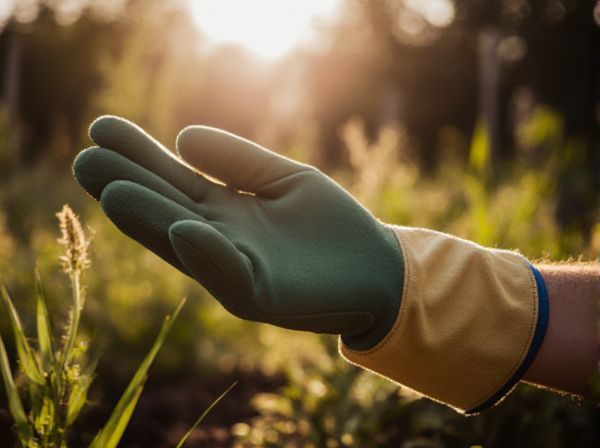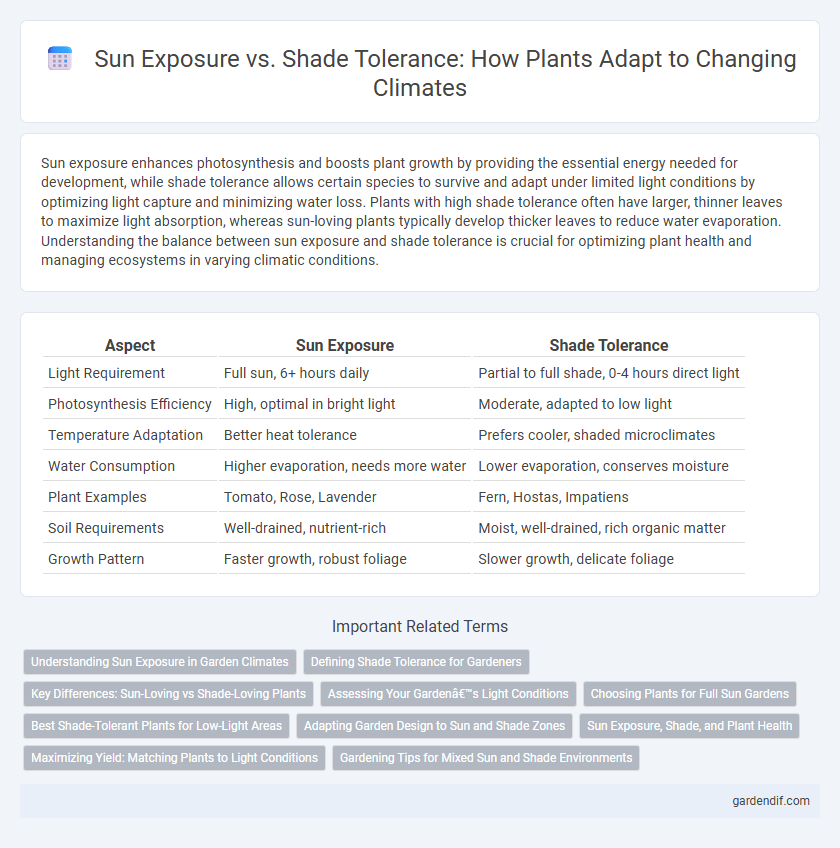
Sun exposure vs Shade tolerance Illustration
Sun exposure enhances photosynthesis and boosts plant growth by providing the essential energy needed for development, while shade tolerance allows certain species to survive and adapt under limited light conditions by optimizing light capture and minimizing water loss. Plants with high shade tolerance often have larger, thinner leaves to maximize light absorption, whereas sun-loving plants typically develop thicker leaves to reduce water evaporation. Understanding the balance between sun exposure and shade tolerance is crucial for optimizing plant health and managing ecosystems in varying climatic conditions.
Table of Comparison
| Aspect | Sun Exposure | Shade Tolerance |
|---|---|---|
| Light Requirement | Full sun, 6+ hours daily | Partial to full shade, 0-4 hours direct light |
| Photosynthesis Efficiency | High, optimal in bright light | Moderate, adapted to low light |
| Temperature Adaptation | Better heat tolerance | Prefers cooler, shaded microclimates |
| Water Consumption | Higher evaporation, needs more water | Lower evaporation, conserves moisture |
| Plant Examples | Tomato, Rose, Lavender | Fern, Hostas, Impatiens |
| Soil Requirements | Well-drained, nutrient-rich | Moist, well-drained, rich organic matter |
| Growth Pattern | Faster growth, robust foliage | Slower growth, delicate foliage |
Understanding Sun Exposure in Garden Climates
Sun exposure plays a crucial role in garden climates, influencing plant growth and health by determining the intensity and duration of sunlight received daily. Understanding the level of sun exposure--full sun, partial sun, partial shade, or full shade--helps gardeners select plant species with appropriate sunlight requirements for optimal photosynthesis and development. Microclimates within a garden, such as shaded areas created by trees or structures, can significantly affect temperature and moisture levels, impacting plant tolerance to sun or shade conditions.
Defining Shade Tolerance for Gardeners
Shade tolerance in plants refers to their ability to survive and grow in low-light conditions by efficiently utilizing limited sunlight for photosynthesis. Understanding shade tolerance helps gardeners select suitable plants for shaded garden areas, ensuring healthy growth and vibrant foliage despite reduced sun exposure. This trait varies among species, with some plants thriving in deep shade while others prefer partial shade, optimizing garden design for diverse light environments.
Key Differences: Sun-Loving vs Shade-Loving Plants
Sun-loving plants require at least six hours of direct sunlight daily to thrive, exhibiting high photosynthetic rates and optimal growth under full sun conditions. Shade-tolerant plants adapt to lower light environments by efficiently utilizing diffuse light, often possessing larger, thinner leaves to maximize light capture. These fundamental differences influence their distributions, with sun-loving species dominating open areas and shade-tolerant species being prevalent in forest understories or shaded landscapes.
Assessing Your Garden’s Light Conditions
Assessing your garden's light conditions involves measuring sunlight intensity and duration to determine plant suitability between sun exposure and shade tolerance. Plants with high sun exposure needs perform best with at least six hours of direct sunlight, while shade-tolerant species thrive in filtered or indirect light for fewer than four hours daily. Understanding these light requirements ensures optimal photosynthesis and growth, enhancing overall garden health and biodiversity.
Choosing Plants for Full Sun Gardens
Plants selected for full sun gardens must possess high sun exposure tolerance, thriving in at least six hours of direct sunlight daily. Species like lavender, coneflowers, and rosemary exhibit robust growth and vibrant blooms under intense solar radiation. Shade tolerance is minimal in these plants, necessitating careful site selection to avoid shaded areas that impede photosynthesis and overall health.
Best Shade-Tolerant Plants for Low-Light Areas
Best shade-tolerant plants for low-light areas include hostas, ferns, and calatheas, which thrive with minimal sun exposure by adapting their photosynthesis processes efficiently. These species possess broad, dark green leaves that maximize chlorophyll absorption, enabling growth in shaded environments with limited light intensity. Incorporating these plants into shaded gardens or indoor spaces enhances biodiversity and maintains healthy ecosystems despite reduced sunlight availability.
Adapting Garden Design to Sun and Shade Zones
Sun exposure and shade tolerance are critical factors when adapting garden design to specific microclimates, influencing plant selection and placement. Plants like lavender and rosemary thrive in full sun zones with at least six hours of direct sunlight, whereas ferns and hostas prefer shaded areas with filtered light. Understanding the sun patterns and creating distinct sun and shade zones optimize plant health, water usage, and overall garden sustainability.
Sun Exposure, Shade, and Plant Health
Sun exposure plays a critical role in plant health by driving photosynthesis, which fuels growth and flowering. Plants adapted to full sun thrive with at least six hours of direct sunlight, boosting chlorophyll production and nutrient absorption. In contrast, species with shade tolerance have evolved mechanisms like larger leaves and chlorophyll-rich pigments to optimize limited light for maintaining vital functions.
Maximizing Yield: Matching Plants to Light Conditions
Maximizing crop yield requires selecting plants based on their sun exposure versus shade tolerance, as each species thrives under specific light conditions. Sun-loving plants like tomatoes and peppers need at least six hours of direct sunlight daily to optimize photosynthesis and fruit production, while shade-tolerant plants such as spinach and lettuce perform better with filtered light or partial shade, reducing stress and bolstering leaf growth. Matching plant varieties to their ideal light environment enhances growth efficiency, reduces water stress, and maximizes overall agricultural productivity.
Gardening Tips for Mixed Sun and Shade Environments
Plants with moderate sun exposure requirements thrive best in mixed sun and shade environments, as they adapt to fluctuating light levels throughout the day. Selecting native species with proven shade tolerance, such as hostas or ferns, combined with sun-loving perennials like coneflowers or daylilies, promotes healthy growth and vibrant blooms. Regular monitoring of soil moisture and strategic plant placement prevents stress from uneven light distribution, optimizing garden resilience and sustainability in variable microclimates.
Sun exposure vs Shade tolerance Infographic

 gardendif.com
gardendif.com